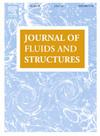Performance evaluation and fast prediction of a pitched horizontal-axis tidal turbine under wave-current conditions using a variable-speed control strategy
IF 3.4
2区 工程技术
Q1 ENGINEERING, MECHANICAL
引用次数: 0
Abstract
A horizontal-axis tidal turbine (HATT) connected to a floating carrier experiences six degrees of freedom due to surface waves, significantly deviating the relative operating velocity and performance. To improve the output power, the HATT must employ a variable rather than conventional fixed speed control strategy, although the outcomes and disadvantages remain unclear. Therefore, this paper develops a CFD model to estimate the response of the HATT in wave-current states, under pitch motion using a speed control strategy. The results indicate that the speed control strategy can effectively improve the output power of the HATT during the pitching motion. The performance is approximated as the sum of a constant and pitch-dependent terms: damping and added mass. The best-fitted performance coefficients of load, power and moment are investigated with the pitch amplitude and period effect. The results indicate that the amplitudes of fluctuations are related with the amplitude and frequency of the pitch due to larger interference in the HATT operating velocities and dynamics of blade performance. The added mass is smaller than the damping term and can be ignored. The findings can be useful for the implementation of modern turbine control systems, to improve the cost-effectiveness of floating tidal energy systems.
波浪流条件下斜向水平轴潮汐能水轮机变速控制性能评价与快速预测
连接在浮动载体上的水平轴潮汐涡轮机(HATT)由于受到表面波的影响,经历了6个自由度,这大大偏离了相对运行速度和性能。为了提高输出功率,HATT必须采用可变而不是传统的固定速度控制策略,尽管结果和缺点尚不清楚。因此,本文建立了一个CFD模型来估计HATT在波流状态下,在螺距运动下使用速度控制策略的响应。结果表明,该速度控制策略能有效提高舵机俯仰运动时的输出功率。性能近似为常数和与音高相关的项:阻尼和附加质量的总和。在俯仰幅值和周期效应的影响下,研究了载荷、功率和弯矩的最佳拟合性能系数。结果表明,由于HATT工作速度和叶片动态性能的干扰较大,波动幅度与桨距的幅值和频率有关。附加质量小于阻尼项,可以忽略。研究结果可用于现代涡轮机控制系统的实施,以提高浮动潮汐能系统的成本效益。
本文章由计算机程序翻译,如有差异,请以英文原文为准。
求助全文
约1分钟内获得全文
求助全文
来源期刊

Journal of Fluids and Structures
工程技术-工程:机械
CiteScore
6.90
自引率
8.30%
发文量
173
审稿时长
65 days
期刊介绍:
The Journal of Fluids and Structures serves as a focal point and a forum for the exchange of ideas, for the many kinds of specialists and practitioners concerned with fluid–structure interactions and the dynamics of systems related thereto, in any field. One of its aims is to foster the cross–fertilization of ideas, methods and techniques in the various disciplines involved.
The journal publishes papers that present original and significant contributions on all aspects of the mechanical interactions between fluids and solids, regardless of scale.
 求助内容:
求助内容: 应助结果提醒方式:
应助结果提醒方式:


